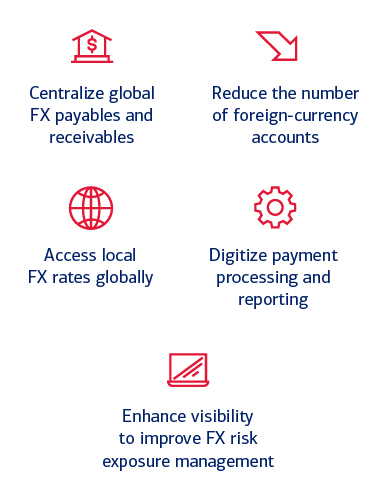3 minute read
Increasing efficiency in cross-border treasury operations
To compete and grow, many corporations have expanded their business internationally. With this growth comes cross-currency transactions that are routinely used by corporates in support of daily business such as vendor/supplier payments, payroll, taxes, and funding local accounts for treasury activities. However, some businesses that pursue this opportunity may encounter inefficiencies brought on by transacting in foreign currencies, especially in higher volumes. Even well tenured practitioners with a lot of FX volume can still struggle to make processes more efficient.
There are are a wealth of existing and evolving technologies that can help automate, improve efficiency, and bring transparency to the management of cross-border transactions.
Corporate treasurers should evaluate their current practices to ensure they are achieving high levels of automation, efficiency, and transparency. There are multiple benefits to this, including reduced costs, simplified reconcilement, and improved forecasting and control.
Fortunately, there are a wealth of existing and evolving technologies that can help automate, improve efficiency, and bring transparency to the management of cross-border transactions. Here, we look at some of the strategies and objectives that treasurers should consider to get started on this path.
Getting started: Objectives
When looking to improve efficiency in FX operations, here are some broad objectives that corporates should strive to achieve:

Four steps toward operational efficiency
The path to efficiency includes four key elements that treasurers should follow in evaluating and optimizing their processes:
1) Determine the best connection
Decide how to maximize execution through omni-channel connections with the FX provider. Choosing the best one depends on each organization’s capabilities, security protocols, and preferences. There are several connection channels available that accommodate the varying technology of different organizations, including:
- Web portal
- File transmission
- API
- Mobile
- ERP
- TMS
2) Choose the right payment type
Determine the best payment type to suit your needs, considering cost, efficiency, and reach.
- High value/low frequency: Wire
- Low value/high frequency: In-country low-value clearing
- Real-time: Instant cross-border payments
- Alternative payment methods: digital wallets and international pay-to-card - Ability to pay a beneficiary directly with only their debit card number
3) Manage currency fluctuations
Traditional risk management programs can be resource intensive and difficult to manage. Some banking providers have begun to offer alternative risk management solutions to derivatives such as providing fixed FX rates for a predetermined period of time. This provides users the benefit of managing the associated FX risk without having to undertake the operational burden of a full-fledged risk management program. This enables a more efficient and accurate means to forecast working capital flows, automates the account reconciliation process, and eliminates the requirement for credit or contracts.
Global expansion presents tremendous opportunities for businesses looking to grow.
4) Reconcile
Utilize advanced trade and settlement reporting to power data-driven decision making. Analyzing transaction patterns can inform decisions and strategies.
Ongoing strategies for FX management
Once the operational practices are in place, corporate treasurers should turn their focus to long-term practices to manage their rates and mitigate risks. These include:
- Reducing FX rate exposure and limiting accounting noise by creating a risk management framework that fits within their operating capacity. This may include outsourcing exposure management to drive efficiency.
- Optimizing intercompany transaction flows and minimizing costs by centralizing intercompany transfers and aggregating activity toward a reduced net obligation
- Improving forecasting by automating complex hedging and eliminating manual processing to reconcile accounts.
- Integrating ERP and TMS systems to enable automation of FX flows from origination to settlement and reconcilement.
Don’t go it alone
Global expansion presents tremendous opportunities for businesses looking to grow. But along with it comes operational complexities around risk, efficiency, and management that can seem daunting. Fortunately, businesses can turn to international financial institutions, like Bank of America, that understand these challenges and offer cutting-edge solutions and expertise.
Danny Doran | Director | Transactional FX Sales Specialist | Bank of America





